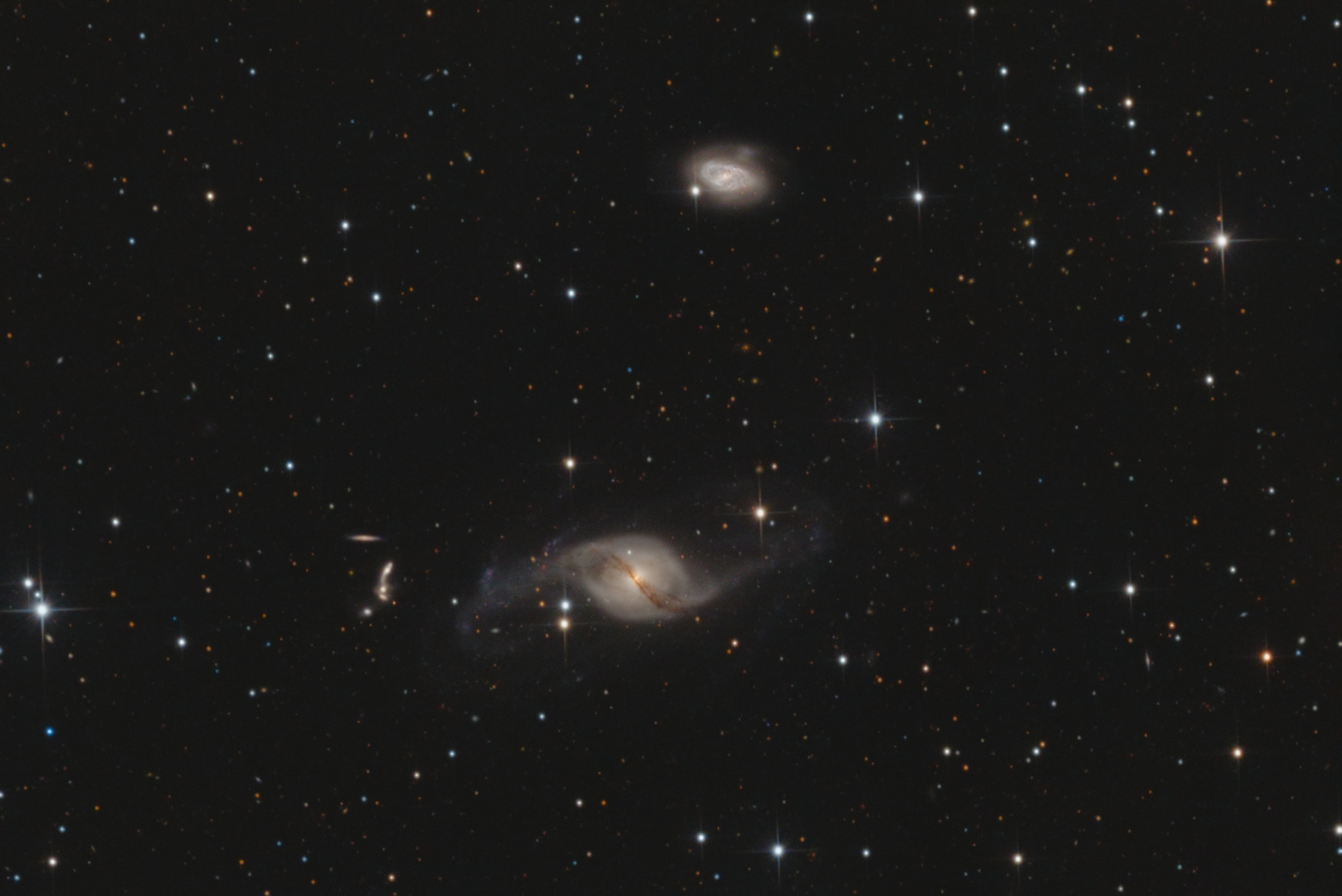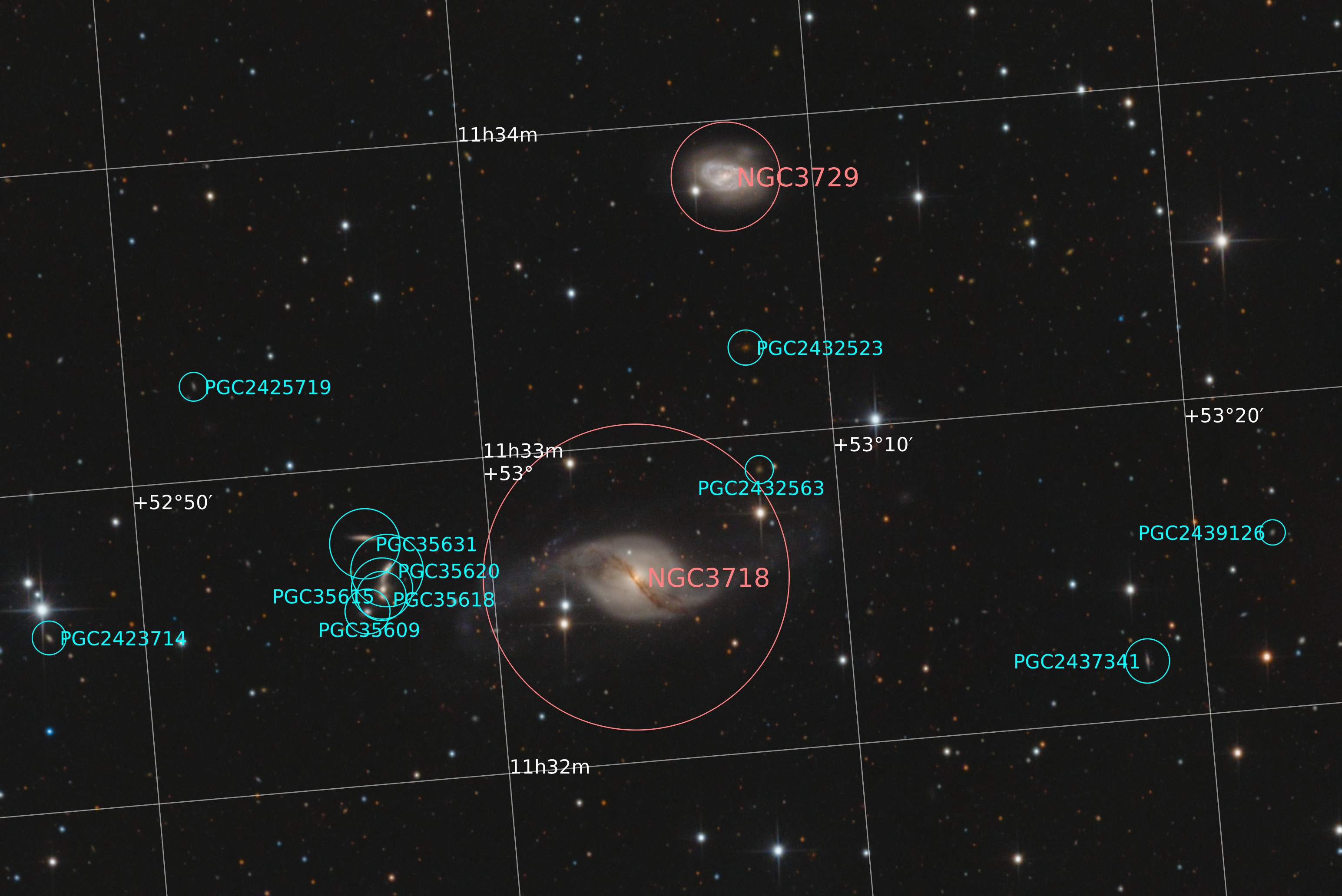
Ursa Major is full of exciting galaxies to see. This image contains a galaxy called NGC3718 (lower center of image) that was likely warped by the smaller barred spiral galaxy NGC3729 (top center of the image). Just to the left of NGC3718 is a chain of 5 distant galaxies commonly known as the Hickson Compact Group 56. Throughout the field are a great many smaller galaxies.
I find myself in awe as I look through the data as the camera brings it in from the telescope in the backyard, and am completely blown away by all the details that can be seen in these galaxies though their light shines from so far away and so long ago.

Follow Me on Instagram | Astrobin
Equipment:
Orion 8in F4.9 1000mm Newtonian Reflector
- Flocked / Primary mirror replaced due to turned-down-edge
Skywatcher F4 Aplanatic Coma Corrector
Astrodon E Series L, R, G, B broadband filters
Celestron CGEM Mount
Self tuned / hacks to get guiding stable include:
Intentional offset polar alignment so dec always pulses in one direction
Balance “west” heavy (rather than the recommended east) so that the ota “falls” onto the gear teeth rather than get “lifted”
Factory Reset hand-controller daily (to prevent cgem from being possessed and forgetting where the meridian is on subsequent night)
Dither in RA only
8in f4.9 Orion Optical Tube Assembly - 1000mm
ASI183mm Pro cooled to -15C
ZWO OAG + ZWO EFW
Acquisition: Data was acquired across seven nights between 2020-03-27 and 2020-04-18
| Date | L | R | G | B | Total |
|---|---|---|---|---|---|
| 20200327 | 00:10 | 00:04 | 00:02 | 00:02 | 00:18 |
| 20200329 | 00:02 | - | - | - | 00:02 |
| 20200401 | 00:02 | 00:46 | 00:46 | 00:46 | 02:20 |
| 20200410 | - | 00:38 | 00:40 | 00:38 | 01:56 |
| 20200413 | 01:04 | - | - | - | 01:04 |
| 20200415 | 02:00 | 00:58 | 01:02 | 01:00 | 05:00 |
| 20200416 | 02:28 | - | - | - | 02:28 |
| 20200418 | 01:08 | 00:28 | 00:28 | 00:32 | 02:36 |
| Total | 15 hr 44 min |
All pre-processing and post-processing was done in PixInsight. Full details below.
The resulting image is a combination of the following steps:
Inspected all subs for bad images with Blink, discarding subs containing clouds
Calibrated all subs with their corresponding master flat and master dark
Used subframe selector to weight all images based on the following weighting
1 |
|
- Selected the best sub from subframe and blink to use as a reference frame for aligning and integration
Breakdown of approved subs after Blink/Subframe Selector:
| Date | L | R | G | B | Total |
|---|---|---|---|---|---|
| 20200327 | 00:08 | - | 00:02 | 00:02 | 00:12 |
| 20200401 | 00:02 | 00:46 | 00:46 | 00:46 | 02:20 |
| 20200410 | - | 00:38 | 00:38 | 00:34 | 01:50 |
| 20200413 | 01:04 | - | - | - | 01:04 |
| 20200415 | 01:52 | 00:56 | 01:00 | 01:00 | 04:48 |
| 20200416 | 02:12 | - | - | - | 02:12 |
| 20200418 | 00:52 | 00:24 | 00:28 | 00:28 | 02:12 |
| ——— | ———- | ———- | ———- | ———- | ——— |
| TOTAL | 06:10 | 02:44 | 02:54 | 02:50 | 14 hr 38 min |
All subs of each filter were aligned to the same reference frame using the Star Alignment process
Integrated all Red frames together, Blue frames together and Green frames together and Luminance frames together to create masters for each color.
Cropped the stacking edges of the integrated masters
[RGB Processing]
Channel combination to combine the integrated Red, Green and Blue frames
Dynamic Background Extraction
Background Neutralization using 4 small preview windows aggregated as a background reference
Image Solver |> Photometric Color Calibration
RGBWorking Space to 1,1,1
Noise Reduction was done using TGV Denoise with a low contrast mask and an autostretched local support, SCNR to remove the green overcast and MMT with a very protective luminance mask as documented by Jon Rista An additional round of DBE was used to remove newly discovered color gradients through the noise reduction process.
Saturated star cores were repaired using the HSV Repaired Separation script and recombined using HSV with Channel Combination
An initial stretched using Arcsinh Stretch followed by Masked Stretch
Additional noise reduction using MMT, ACDNR was applied
A final histogram curve and a masked C-Curve was applied to push the color data.
A contours based star mask was created and morphological selection used to reduced the overall size and intensity of the medium and larger sized stars
The RGB image was placed asside for Luminance Processing Next
[Luminance Processing]
All approved L, R, G and B frames used to create each master were re-integrated together using the best “L” frame as integration reference to produce a super-luminance
Two Rounds of Dynamic Background Extraction were applied to remove gradients throughout the field
Independently produce a noise reduced image and a sharpened image
Noise Reduction was done using TGV Denoise with a low contrast mask and an autostretched local support and MMT with a very protective luminance mask
Deconvolution was done on a separate copy of the luminance with
No deringing
wavelet regularization with 5 layers and strong but reducing amounts/thresholds
- A combination of starmask and clone stamp was used to produce a series of star masks that together covered all ringing artifacts produced by deconvolution
The noise reduced copy and the sharpened copy were combined using a luminance-based mask where the high-signal areas were filled in from the deconvolution copy and the low-signal areas were filled in from the noise reduction copy
Decon*CombineMask+NR*~CombineMaskThe resulting luminance was stretched using Masked Stretch, no clipping, and the same background preview windows aggregated. The tail was brought in using histogram transformation, and the stretch was repeated.
Morphological selection was performed on the stars to reduce their intensity, and Motion Blur Deconvolution was performed on the star cores themselves to correct from the poor guiding performance of the CGEM at this image scale.
Two rounds of Local Histogram Equalization was performed to slightly bump the fainter outer regions of NGC3718
The final processed luminance image can be downloaded here: Completed Super Luminance
[Combination and Final Adjustments]
The Luminance and the RGB Image was brought together using the LRGB Combination Tool applying the processed/stretched luminance to the processed/stretched RGB images. Chrominance noise reduction was enabled on combination.
Final round of chrominance noise reduction on the stars slight S-Curve to increase the overall contrast. The star cores of the brighter stars were cleaned up with a small amount of convolution and a mask.
An ICC Profile was applied to enable Black Point Compensation
Constructive criticism is welcome. Let me know what you think! How can I improve?